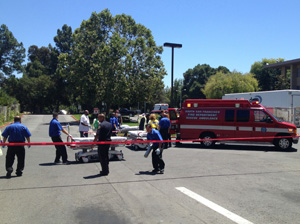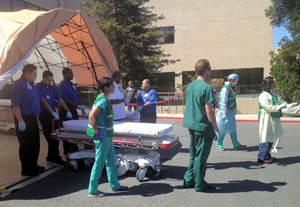July 8, 2013 - By Robert Dicks

The first ambulance arrives at Stanford July 6 with victims of the Asiana Airlines crash at San Francisco International Airport. Fifty-five patients were brought to Stanford's two hospitals.
Years of disaster training and preparation culminated in an extraordinarily executed response July 6 when 55 injured passengers were brought to Stanford Hospital and Lucile Packard Children's Hospital for treatment after the crash of Asiana Airlines Flight 214 at San Francisco International Airport.
The Stanford hospitals were among nine in the Bay Area that were called into emergency action to evaluate and treat the crash victims. The disaster claimed two lives.
"The many hours we devote to disaster planning and training really paid off," said Brandon Bond, administrative director of the Office of Emergency Management for Stanford and Packard hospitals. "Throughout both of our hospitals, everyone immediately knew what to do to evaluate and treat these patients while maintaining normal hospital operations."
That preparation and readiness meant that emergency professionals from the Stanford Level-1 Trauma Center, the Marc and Laura Andreessen Emergency Department and the Office of Emergency Management had an incident response plan in place that had been well-rehearsed during many emergency drills and mock scenarios.
Officials at Stanford Medicine quickly activated the hospital command center after receiving word of the incoming casualties. They initiated a "code triage," bringing together cross-functional teams from emergency, trauma, operations, security and more to safely and efficiently coordinate the expected surge of patients.

Teams await the arrival of the crash victims at Stanford's Emergency Department.
Eric A. Weiss, MD, medical director for the Office of Emergency Management, said the mobilization was rapid. "Within 30 minutes we had admitted or discharged most of the patients who were previously being treated in the emergency department, and we mobilized over 150 health-care providers dedicated to responding to the airplane tragedy," said Weiss, who is also an associate professor of emergency medicine at the School of Medicine. "This included physicians, nurses, technicians, clerks, registration personnel, social workers, translators and other vital specialists from throughout Stanford and Packard Children's hospitals."
To evaluate and treat the influx of trauma patients from the crash, the hospitals mobilized seven trauma teams with fully trained surgeons and five perioperative teams. "We also implemented our rapid admission and rapid discharge plan, plus we set up an expansive and well-staffed triage area outside the emergency department to accommodate the surge of additional patients," Weiss said.
Of the 55 patients evaluated and treated, 11 were admitted to Stanford Hospital and seven to Packard Children's. "The injuries were of varying degrees," said David Spain, MD. As chief of trauma and critical care surgery at Stanford, Spain was already on site when patients started arriving by ambulance and helicopter.
"Some of the injuries were life-threatening and serious," added Spain, who is also a professor of surgery at the School of Medicine, noting that several surgeries were required.
Those involved in coordinating the hospitals' response said it was obvious that the many hours devoted to emergency preparedness were worthwhile. "Everyone came together right away to deal with a rapidly evolving situation and do what they do best, which is save lives," said Bond, who also leads the hospitals' emergency preparation for other types of crises, such as power outages and earthquakes.

Staff members in the command center organize Stanford Medicine's response to the influx of crash patients.
When Ann Weinacker, MD, chief of staff at Stanford Hospital & Clinics, reported to the command center shortly after the midday notification went out, it was already operational and fully staffed. "What was remarkable was how calm and smoothly everything was running. It was incredibly well-organized," she said.
She also did a walk-through of the emergency department and was amazed by what she saw. "The emergency department was calm," said Weinacker, who is also a professor of critical care medicine at the medical school. "There was not a lot of drama. It was almost like business as usual — only there were many more people.
"The staff did a remarkable job of taking care of things," she added. "I was just blown away with how well this worked and how expert everyone was in their job. Mostly we're glad there was no greater loss of lives and no more severely injured people than there were. We all fear something really massive, where there are many, many more victims than there were."
As treatment of the remaining hospitalized crash victims continues, Christy Sandborg, MD, vice president of medical affairs at Packard Children's and a professor of pediatrics at the School of Medicine, reflected on the preparation and commitment of so many.
"The breadth of support in an emergency like this is impressive and heart-warming," said Sandborg, who also acknowledged the many social workers and interpreters assisting the injured. "The planning, teamwork and quick thinking were truly inspiring, and it reflected a compassion and care that makes us all very, very proud."
Lloyd Minor, MD, dean of the School of Medicine, commended the teams for the care they delivered. "Stanford Medicine's faculty and staff have done an amazing job treating people from the crash," Minor said. "As often happens in a crisis, many individuals stepped up and worked tirelessly to provide the best possible medical and social care to patients. But it was more than a willingness to help that was on display; it was the work of professionals trained to respond in an emergency situation. While this was the first time in decades that we activated our mass-casualty plan, staff took on their assigned roles with intelligence, compassion and creativity."
Robert Dicks is the senior media relations director for Lucile Packard Children's Hospital.
About Stanford Medicine
Stanford Medicine is an integrated academic health system comprising the Stanford School of Medicine and adult and pediatric health care delivery systems. Together, they harness the full potential of biomedicine through collaborative research, education and clinical care for patients. For more information, please visit med.stanford.edu.